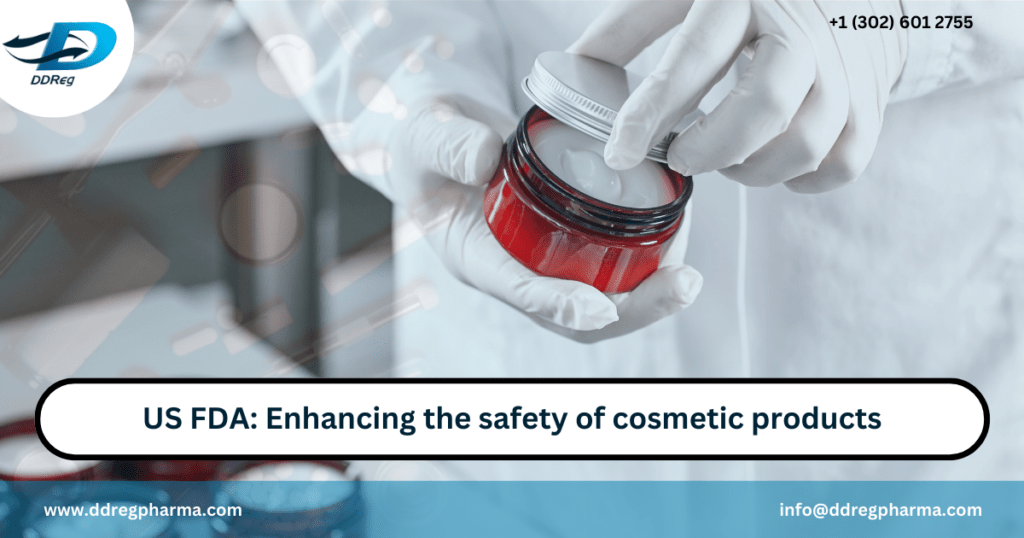In the ever-evolving landscape of personal care and aesthetics, cosmetic products have risen to prominence and have wielded significant influence over individual and societal perceptions of allure. Yet, the journey from development to commercialization is underpinned by a complex tapestry of regulations designed to ensure consumer safety, uphold product integrity, and govern industry practices.
In the United States (US) alone, an average consumer may use anywhere between 6 and 12 products on a daily basis [1]. As its commitment towards public health, the US FDA is actively working to establish a more robust approach towards the safety of cosmetic products.
Registering and Listing of Cosmetic Product Facilities and Products
A significant stride in the realm of regulatory guidance has been taken by the US FDA through the release of draft guidance which addresses the registration and listing requirements for cosmetic product facilities. Within this comprehensive guidance, a panorama of obligations and procedures is outlined for both individuals and businesses engaged in the intricate processes of manufacturing or processing cosmetic products intended for distribution within the United States.
Cosmetic product regulation requires all individuals that own or operate facilities which engage in the manufacturing or processing of a cosmetic product for distribution in the USA to register each facility with the FDA. Previously, the US FDA implemented a voluntary cosmetics registration program which ended in March 2023. According to Dr. Linda Katz, the director of FDA’s Office of Cosmetics and Colors, the registration and listing information shall support the agency in 1) identifying facilities that are involved in the production of cosmetics which may cause adverse events (AEs), 2) recalling un-sanitary products, 3) administering product testing and safety surveillance programs, 4) inspections, 5) establishing products that are in violation of the law.
Key Points Mentioned in the Guidance:
The FDA’s draft guidance presents a constellation of critical insights for both individuals and businesses engaged in the manufacturing or processing of cosmetic products intended for distribution within the United States [2].
Registration Requirements
The FD&C Act leaves no room for ambiguity when it comes to facility registration. Entities operating cosmetic product manufacturing or processing facilities within the U.S. must meticulously register each establishment with the FDA. However, exemptions do exist, and they embrace:
-Small Businesses:
Certain small-scale cosmetic manufacturers and processors are granted an exemption from the facility registration mandate, acknowledging the unique challenges they face.
-Facilities with Drug and Device Requirements:
Facilities subject to the FD&C Act’s requirements for drugs and devices are also exempt from facility registration, provided that they do not produce cosmetics falling outside the scope of those requirements
Obligations and Timelines
Any changes to registered information must be communicated within a span of 60 days from the occurrence of said changes.
Registration Renewal: To maintain a continuous presence within the regulatory sphere, facilities are required to renew their registrations every two years.
Product Listing
Annual Listing: Responsible persons – the manufacturers, packers, or distributors – are charged with submitting an annual listing for each cosmetic product. This listing encompasses ingredients, product name, contact information, and more.
Small Business Reprieve: Small businesses meeting specific criteria are granted a welcome exemption from both registration and listing requirements, acknowledging their unique stature and challenges.
The Electronic Submission Portal
In a harmonious union of regulation and modernity, the FDA is poised to unveil an electronic submission portal. Expected to launch in October 2023, this portal offers a streamlined avenue for registration and listing processes. While electronic submissions are the vanguard, a traditional paper form alternative shall also be extended.
Crafting Comprehensive Information
Facility registration unveils a tapestry of details, including owner/operator information, physical address, contact specifics, facility registration number, product categories, and more. An optional flourish comes in the form of providing parent company names and additional contacts.
Product Listing Details
Product listing, akin to a cosmetic revelation, unfolds with an array of specifics. These include the facility registration number, the responsible person’s contact, product name, ingredients, and more. Additional optional embellishments encompass parent company names, label images, webpage links, and supplementary contacts.
Attestation
Individuals embarking on the registration and listing journey are solemnly required to attest to the accuracy of the disseminated information.
Submission Timeline and Fees
Industry stakeholders are summoned to embark on their registration and listing voyage before the December 29, 2023 deadline. The process bears no financial burdens, as there is no fee associated with submitting registrations or product listings under Section 607.
Conclusion:
The FDA’s new guidance stands out as a guiding light among complex cosmetic rules. As the cosmetic industry grows, these guidelines help balance strict rules with the allure of cosmetics. In a world valuing both beauty and safety, these rules aim to ensure our cherished cosmetics are made with care and safety in mind.
References and Further Reading:
[1] US FDA. News Release: FDA Issues Draft Guidance for Registration and Listing of Cosmetic Product Facilities and Products. United States Food and Drugs Administration. 2023
[2] US FDA. Registration and Listing of Cosmetic Product Facilities and Products: Guidance for Industry. United States Food and Drugs Administration. 2023

